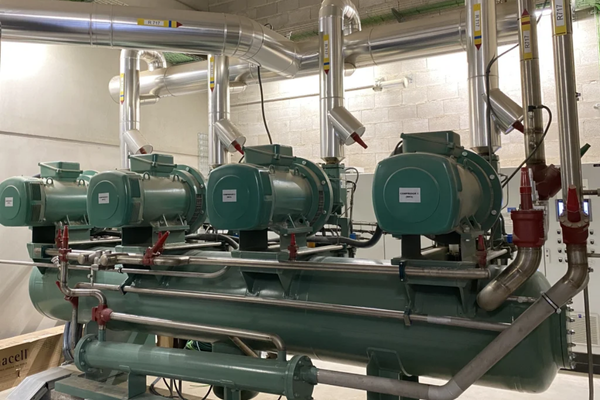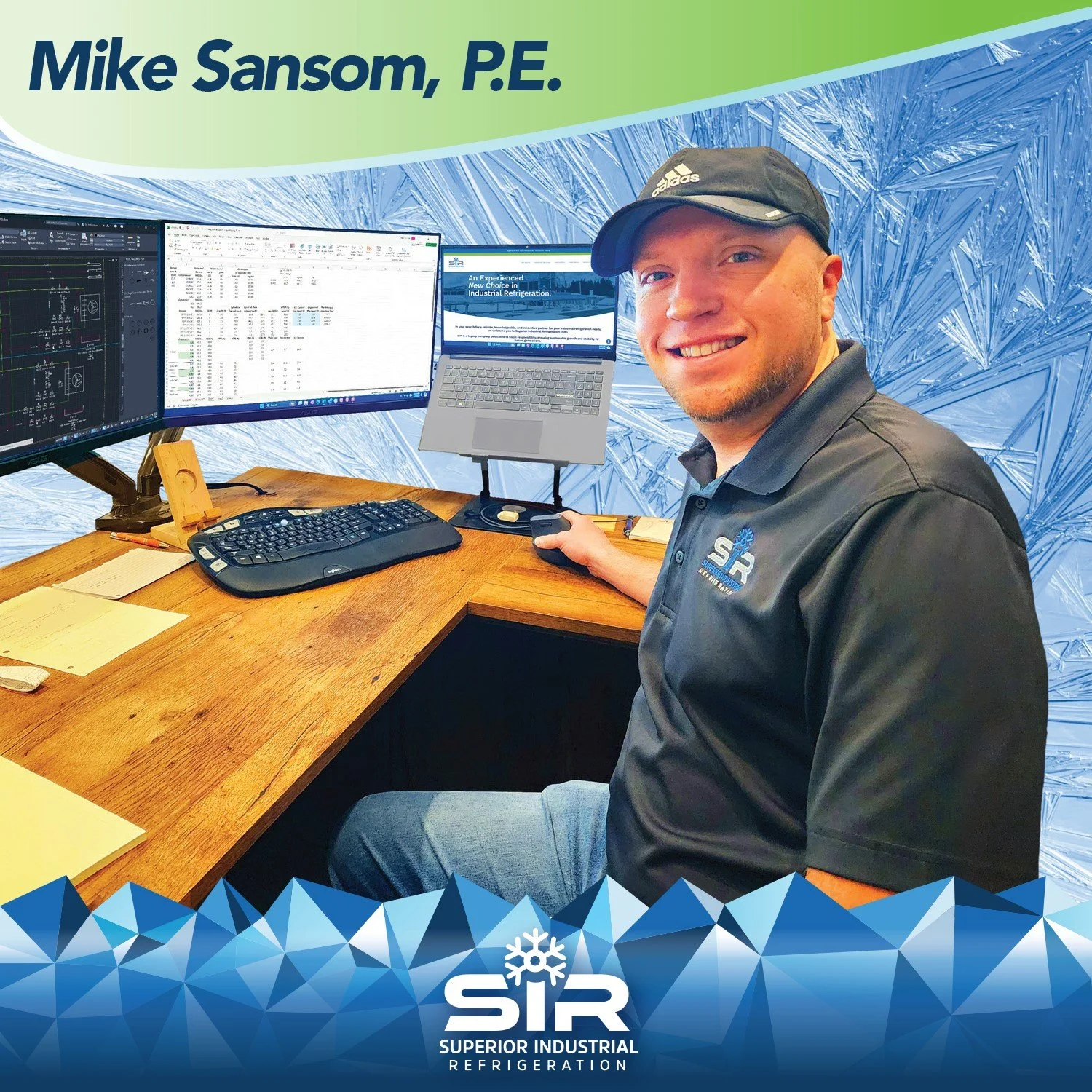Still Cool Under Pressure
Ammonia Refrigeration Evolves Amid Growing Competition
Ammonia (NH3/ R717) refrigeration continues to dominate industrial applications across the United States and European Union, but the sector is undergoing significant transformation as operators balance traditional advantages with evolving safety requirements, workforce challenges, and competition from alternative refrigerants. While ammonia maintains its stronghold in large-scale facilities, new technologies and regulatory pressures are reshaping how the industry approaches system design and implementation. How is the landscape changing?

Market Dominance Faces New Pressures
In the United States (US), ammonia maintains an overwhelming presence in industrial refrigeration, occupying an estimated 80% to 90% of the market, according to Kurt Liebendorfer, VP of Industrial Refrigeration Business Development at Evapco. However, this dominance has declined slightly over the past decade as the uptake of carbon dioxide (CO2/ R744) refrigeration systems moves from the supermarket/ retail sector to the industrial sector as well. "This decline has primarily occurred in the new cold storage sector, where many new cold storages have been built over the same 10-year period, and some end-users have been attracted to non-ammonia solutions," Liebendorfer explains.
The competitive landscape is evolving as CO2 systems gain ground, particularly in smaller industrial applications. Bernhard Blaeser, Head of Industrial Refrigeration at Bitzer, notes that in the lower-capacity industrial refrigeration sector, CO₂ appears to be gaining ground in the European Union (EU) due to subsidies and initial price advantages for certain applications, as well as the expansion of traditional commercial CO₂ original equipment manufacturers (OEMs) into the industrial refrigeration space. However, he explains that ammonia still has a very strong presence in the higher-capacity industrial sector due to its highly efficient thermodynamic, environmental, and economic properties. “This is set to continue for the foreseeable future, as the capital expenditure gap between these two refrigerants shrinks with the size of the installation.”
A portion of ammonia's market share decline has also been captured by packaged industrial HFC and HFC/ HFO blends in new cold storage facilities, explains Liebendorfer. However, with pending HFC restrictions from the Environmental Protection Agency (EPA)'s American Innovation and Manufacturing (AIM) Act taking effect in the US, he notes a partial reversal in this HFC uptick, benefiting both ammonia and CO₂.

Despite these competitive pressures, ammonia's fundamental advantages remain compelling. "Ammonia in industrial refrigeration applications has been, and will continue to be, a dominant presence, even as other refrigerant options are embraced and abandoned," says Mike Sansom, Engineering Manager at Superior Industrial Refrigeration (SIR). "Ammonia is native to the environment, it's abundant, and inexpensive. Its risks are well documented and understood and are relatively simple to minimize."
Addressing Industry Barriers
While ammonia maintains a strong market presence, several barriers continue to influence adoption patterns. Sansom identifies misconception and misguided interpretation as primary obstacles, though he notes that legislatively, ammonia's use as a refrigerant continues to have strong support thanks to organizations like the International Institute of All-Natural Refrigeration (IIAR, formerly known as the International Institute of Ammonia Refrigeration) that set standards for system design and operation. There is an ongoing campaign to educate and inform the public and elected officials about the benefits of natural refrigerants.
The life safety issues associated with ammonia's toxicity represent the primary hurdle, along with the added costs of associated technical remedies, according to Liebendorfer. A secondary hurdle is the cost of ammonia systems for smaller facilities, as the larger an industrial refrigeration system is, the greater the "sweet spot" for ammonia being the preferred solution, he says.
Regulatory Environment Shapes Strategy
The regulatory landscape continues to influence ammonia adoption patterns, though the impact varies significantly by region and application. In the US, the EPA's AIM Act has created a recent uptick in the application of low-charge ammonia systems and transcritical CO₂ systems over the last 18 months, says Liebendorfer.
However, regulatory uncertainty remains a factor. Liebendorfer notes that with the current administration in the US seeking to scale back some federal regulations, there are interested HFC parties advocating for a revision to the AIM Act that would increase the allowable Global Warming Potential (GWP) for cold storage facilities from its current 150 limit up to 700 GWP. The outcome of this effort will determine the continued regulatory pressure favoring natural refrigerants.
In the EU, stricter local legislation is making it increasingly difficult to operate smaller ammonia plants in certain countries, facilitating the move to CO₂, Blaeser explains. However, the ammonia sector is responding with countermeasures, including the installation of more low-charge and direct expansion (DX) ammonia solutions to address this legislation.
Low-Charge Systems Drive Innovation
The most significant trend reshaping the ammonia refrigeration sector is the rapid adoption of low-charge systems that use less refrigerant than traditional systems. This shift addresses both safety concerns and regulatory requirements while maintaining ammonia's thermodynamic advantages.
Factory packaged and field constructed low-charge ammonia systems are becoming more prevalent over the historical "larger-charge" ammonia systems for new installations, says Liebendorfer. OEMs such as Evapco are actively building and selling packaged low-charge ammonia systems, along with many design-build industrial refrigeration contractors installing them, some of which are also building their own packages.
The push toward low-charge systems represents more than just a safety improvement. Hernan Hidalgo, Director of Sales for Industrial Refrigeration at Danfoss Climate Solutions, explains that innovative low-charge ammonia systems, such as Danfoss’ NeoCharge, can result in efficiency gains of up to 20% and reduce ammonia charge by up to 50%. The technology is suitable for both new and retrofit installations, offering machine learning algorithms that deliver efficiency and reduce operator interaction.
Liebendorfer lists recent technological improvements in low-charge ammonia packages, which include advanced controls, innovative system packaging, methods of refrigerant feed such as injectors and direct expansion, and the availability of alternate condensing technologies. These developments are making low-charge systems increasingly attractive for operators seeking to balance performance with safety and regulatory compliance.
Hidalgo also notes that an increased focus on the mechanical integrity of piping and components has led to the adoption of stainless-steel valves and other relevant equipment.
Research and Development Drives Progress
The industry is witnessing significant research and development activity focused on optimizing ammonia system performance and reducing environmental impact. EU research initiatives are particularly noteworthy, with several key areas of investigation emerging from recent technical conferences.
Blaeser cites examples from technical papers and case studies presented by various leading European component providers at the recent Industrial Refrigeration Network Conference (IRN2025), which took place in June. Laboratory research is examining the most energy-efficient means of defrosting ammonia evaporating coils, including optimization of methods, timing, duration, defrost cycles, and temperature. More advanced vapor quality control systems are being developed to optimize evaporator performance and make low-charge direct expansion ammonia systems easier to operate.
Work is also progressing on reducing the charge in large ammonia systems by reducing the circulation rate in pump circulation systems, thereby increasing capacity with the same charge for future expansion without redesigning the system. Additionally, research is investigating how to reduce specific energy consumption in large cold storage facilities via real-time integrated control loops that interactively manage variable speed drives on all compressor, condenser, and evaporator fans and pumps, constantly adapting to operating demands.
Hybrid Solutions and Competitive Technologies Emerge
An interesting development in the sector is the increasing adoption of hybrid refrigeration systems that combine ammonia with CO₂. Blaeser reports seeing "an increasing number of CO₂/ ammonia cascade plants coming online, where the booster stage is subcritical CO₂ and the high stage is ammonia. This combination of refrigerants offers the operator the best coefficients of performance within their respective optimal operating ranges."
This hybrid approach allows operators to leverage the strengths of both refrigerants while addressing specific application requirements and regulatory constraints.
Meanwhile, CO₂ technology continues advancing rapidly. Hidalgo notes that advancements in compressor performance and reliability at high pressure, PLC-based controls, and larger and more reliable high-pressure valves and ejectors are enabling the design of larger CO₂ systems suitable for greater capacities while delivering the safety and performance needed.
Liebendorfer observes that the "industrialization" of transcritical CO₂ packages is reshaping the US industrial refrigeration market. CO₂ systems, which came to the industrial market from the commercial retail sector, are scaling up system sizes to much larger facilities while applying "more industrial" controls, electrical gear, insulation systems, and various operator-friendly features demanded by industrial users.
Workforce Challenges Present Ongoing Concern
A persistent challenge facing the ammonia refrigeration sector is the diminishing experience level in the trained workforce. Sansom identifies this as a significant industry trend, noting that he would "like to see an increase in refrigeration service and technician training programs to help fill the gaps left by the retiring veterans of our industry."
This workforce challenge extends beyond simple numbers to encompass the specialized knowledge required for ammonia systems. The complexity of modern low-charge systems and advanced control technologies requires technicians with both traditional ammonia experience and familiarity with new technologies.
Market Growth and Infrastructure Expansion
Despite competitive pressures, the overall industrial refrigeration market continues to expand, creating opportunities for ammonia systems. Sansom reports that "the trend is expansion as far as the volume of refrigerated industrial space; at least that's what I'm seeing. Cold storages are upgrading and expanding, and food production is growing with increasing demand."
Statistical data support this growth trajectory. According to the 2024 ATMOsphere Natural Refrigerants: State of the Industry market report, there were 1,230 industrial sites using low-charge ammonia systems in North America as of December 2024, representing a 17% increase from 2023. This includes 842 sites in the US and 388 in Canada. The year-over-year growth rate for packaged units was particularly strong at 38% compared to 15% for central systems.
In Europe, the growth has been even more dramatic. ATMOsphere estimates there were 3,600 industrial sites using low-charge ammonia systems in Europe, representing a 7% growth rate from 2023. From June 2021 to December 2024, the number of industrial facilities in Europe using low-charge ammonia has grown by 47%, according to the market report.
Future Outlook
The ammonia refrigeration sector stands at a crossroads where traditional advantages must be balanced against evolving market requirements. While ammonia maintains its dominance in large-scale industrial applications due to its superior thermodynamic, environmental, and economic properties, the industry is successfully adapting through technological innovation, with CO2 gaining ground in some applications.
The development of low-charge systems, advanced controls, and hybrid solutions demonstrates the sector's ability to evolve while maintaining its core advantages. As Hidalgo concludes, "It is an exciting time to help drive efficiency, reduce waste, and help create a more sustainable industrial refrigeration industry."
The continued growth in low-charge installations, coupled with ongoing research efforts, suggests that ammonia refrigeration will maintain its critical role in industrial applications. Success will depend on the industry's ability to address workforce training needs, continue innovation, and effectively communicate ammonia's long-term value proposition to end users navigating an increasingly complex refrigerant selection process.
